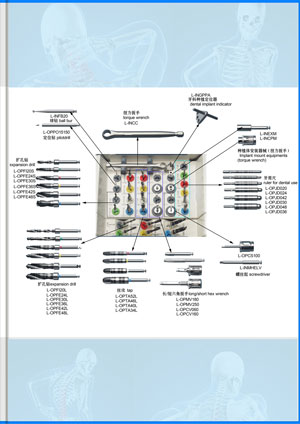Three Ways to Choose Dental Implants
1.Mechanical properties of implants
What kind of implant can withstand pressure more?
Mechanical properties of implants refer to the tensile strength and fatigue resistance of implants.
When an implant is implanted into the mouth, it must bear the corresponding occlusal force. However, if due to the patient's own reasons, there is not enough bone to support the corresponding size of the implant, artificial bone grafting is required.
Or choose thinner implants. But at present, the tensile strength of most fourth-grade pure titanium implants is only 550 MPa. When the occlusal force is too large, it is easy to cause an intraoral fracture.
Want to do minimally invasive surgery, while ensuring that the implant does not break due to insufficient strength. At this time, we need a material with better mechanical properties - Ti-Zr alloy, which can not only make the implant smaller but also bear greater occlusal force.
Zr (zirconium) added to pure Ti (titanium) can effectively increase the strength of implants by 30%, and the strength can reach more than 850 MPa.
2.Biocompatibility of Materials
What implants can withstand long-term testing?
As an "outsider", whether the planting can pass the test of your autoimmune system, and is well compatible with surrounding tissues, without rejection. At the same time, it does not cause acute and chronic inflammation of tissues, which is the key to the long-term survival of implants.
Ti-Zr alloy is the only alloy with the same biocompatibility and superior to the fourth-grade pure titanium. Implants with this material can live in peace with surrounding tissues and lay a solid foundation for future bone bonding.
3.Surface treatment of implants
What kind of implants can retain support?
After implant implantation, in order to grow well, it is necessary to get the support of osteoblasts in the blood (osteoblasts attached to the implant surface).
First, let's get to know osteoblasts!
Osteoblasts are oval or cubic cells with a diameter of 20-40 microns. When they attach to the implant surface for further differentiation, they will form small hands and feet (stromal processes) of 2-4 microns, and eventually form new osteoblasts, which we often say grow new bone.
In order to obtain the enthusiastic support of osteoblasts, it is necessary for the surface of the implant to conform to the shape and size of the osteoblasts, so that the osteoblasts will willingly settle on the surface of the implant.
After the osteoblasts attach to the implant surface, they will grow many small hands and feet (matrix protuberances) of 2-4 microns, and then use both hands and feet to firmly adhere to the mid-to-surface, and then differentiate into osteoblasts, which is often said to grow new bone to form implant bone bonding. Therefore, the surface morphology of implants should not only consider the size of osteoblasts but also not forget his hands and feet.
It usually takes 12 weeks or more for implants to bond firmly to bone. Titanium-zirconium alloy implants with hydrophilic active surfaces greatly enhance the "attraction" of implants. Easily draw blood rich in osteoblasts and various fibrins around itself and quickly form blood clots.
At the same time, the active surface accelerates the differentiation of osteoblasts into osteoblasts, forming new bone between the implant and the old bone. Only 3-4 weeks can form a strong bone bond!

 +86-021-50327060
+86-021-50327060
 zq@lzqtech.com
zq@lzqtech.com
 Medical Instrument
We can achieve perfect edge quality and dimensional tolerance up to±0.0005mm (±0.5μm) in the process of micro, ultra-long, ultra-thin, super-abrasive, impact-resistant, high-precision and combined ... VIEW MORE
Medical Instrument
We can achieve perfect edge quality and dimensional tolerance up to±0.0005mm (±0.5μm) in the process of micro, ultra-long, ultra-thin, super-abrasive, impact-resistant, high-precision and combined ... VIEW MORE Implant
Corresponding and matching drills and tools of different types, forms, shapes, structures can be high precisely ground to mold according to different brands and different types of implants forms, shap... VIEW MORE
Implant
Corresponding and matching drills and tools of different types, forms, shapes, structures can be high precisely ground to mold according to different brands and different types of implants forms, shap... VIEW MORE Cutting Tools
Super-hardness machining for special, non-standard new ite ms with different size and tolerance. VIEW MORE
Cutting Tools
Super-hardness machining for special, non-standard new ite ms with different size and tolerance. VIEW MORE Accessory Parts
we can customize for you according to your samples or drawings for any manufacturing of ceramic,carbide,stainless high-speed steel, stainless steel, titanium alloy, titanium diamond, etc series, hig... VIEW MORE
Accessory Parts
we can customize for you according to your samples or drawings for any manufacturing of ceramic,carbide,stainless high-speed steel, stainless steel, titanium alloy, titanium diamond, etc series, hig... VIEW MORE


 +86-021-50327060
+86-021-50327060 
 NO.1269 Plant, Jinhu Road, Jinqiao Export Processing Zone, Pudong New District, Shanghai, China.
NO.1269 Plant, Jinhu Road, Jinqiao Export Processing Zone, Pudong New District, Shanghai, China. 
